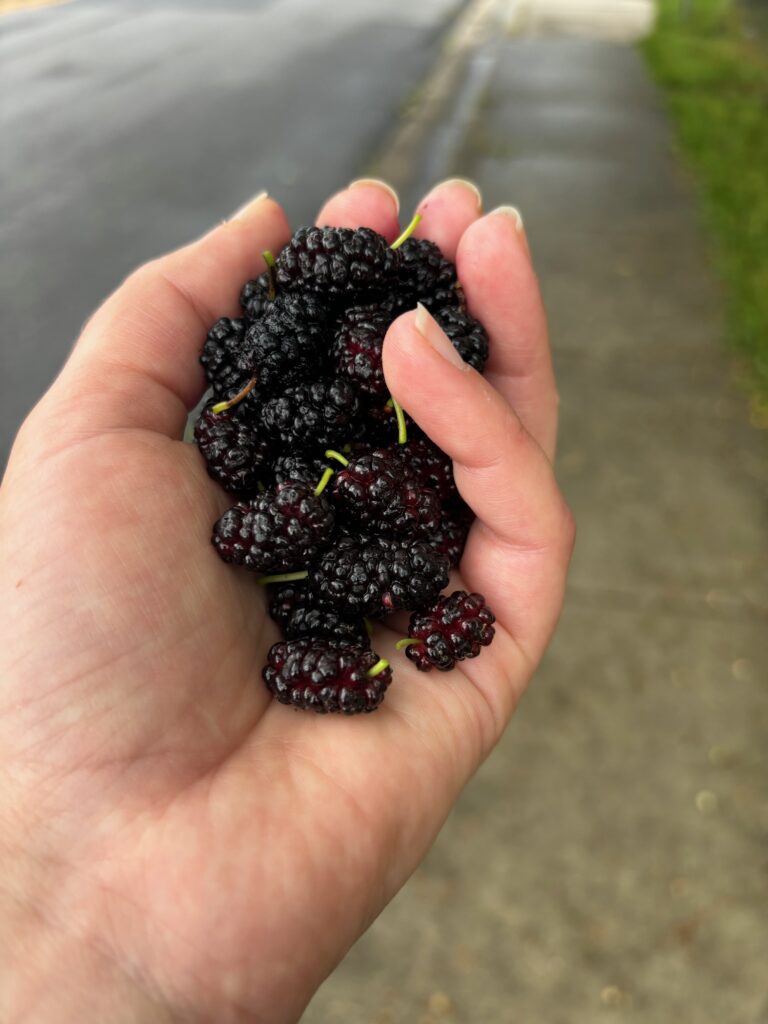
As I ran, mulberries bounced out of my hand, trailing behind me as if I was some sort of fruit-based Hansel and Gretel. I paused in my run to pick mulberries from a neighbor’s tree – they littered the sidewalk, so they weren’t going to be missed – and had overestimated how many I could hold while jogging. Bringing them home, I announced, “Mulberries!” and dropped them in a plastic bowl. My older son ate them quickly, staining his mouth dark purple.
The next day, the kids and I went on a foraging walk around our neighborhood. Mulberry trees are common, as are grape vines that have long since gone wild. As I told them, I think some of these sources of fruit are an artifact of the history of our neighborhood. When our house was built in the 1950s, a lot of people in the neighborhood grew much of their own food. Our neighborhood is a historically Black community and although it was fairly suburban (not rural) back then, segregation limited shopping options – much like today in many areas. People relied on each other far more than they do today, partly because they had to.
I knew most of this from my beloved neighbor Wilma, who passed away when the kids were small. She grew up in the neighborhood and her family had been there for generations. She told me about how she would take apples from the neighbors’ apple trees – some who weren’t very happy about it – and how many people raised chickens and pigs in their backyard. She recalled how men would go fishing and bring back their catch for a community fish fry. When I started gardening, she said I was carrying on that legacy. Later on I learned that she had a bet with my other neighbor that my tomatoes would fail, but Wilma was proud to tell me that she lost the bet!
Walking through the neighborhood, seeing these signs of how this history still persisted, reminded me of Wilma and the people who lived here before us.
The walk also provided a connection to the plants and landscape of our neighborhood. Humans have a tendency to notice animals and ignore plants. The more ordinary the plant, the more it passes by our notice. At the beginning of COVID, we got to know our neighborhood far better than we ever had before. I started identifying the wild and cultivated plants around us on my daily walks. Much to my surprise, one day I noticed that there was a familiar-looking bush along the road. It looked a whole lot like a bush we pick berries off of when we camp at a nearby state park. Upon further inspection, I discovered my hunch was right – they were wine berries! They’re an Asian raspberry. The more I looked, the more I found. I found wild blackberries as well. Pointing out these treasures that we so easily passed by was like revealing a hidden world to my kids.
Forgaging also brings our attention to the seasonality of food. The mulberries only lasted a week or so before they were gone. Wineberries are a summer fruit – in some places, they’re called juneberries because that’s when they’re ripe. They weren’t ready yet on our walk, so we knew we’d have to check back later. You pick and eat these things in the brief time you can because they’ll be gone as quickly as they appeared.
Of course, not every neighborhood will have the wealth of edible plants that we do. Or even if you do, you may not have the expertise to identify them. One way to ease your way into foraging is to pay for a foraging walk with a local expert. We did one at a park and it was absolutely delightful. Another thing to note is not to rely on plant identification apps, as easy as they are. Many of them are consistently inaccurate; some have even identified horrifically toxic mushrooms as edible.
Even if you don’t eat anything from your neighborhood, it still builds your awareness just to observe the plants around you. Notice what the trees and flowers are and what role they play in the local ecology. Build those connections and awareness – they will bring so much depth to your everyday life if you let them.
Our neighborhoods are so much more than the human neighbors that we share them with. The plants around us can reveal the human and natural history of what has come in the past and give us a tool to be more sustainable into the future.